Silicone Materials for Flexible Optoelectronic Devices
Abstract
1. Introduction
2. The Main Properties of Silicone Materials for Optoelectronics
2.1. Transparency, Morphology, and Adhesion
2.2. Mechanical Properties and Self-Healing
2.3. Luminescent Properties
2.4. Electrical Conductive Properties
3. Conclusions
Author Contributions
Funding
Data Availability Statement
Conflicts of Interest
References
- Yilgör, E.; Yilgör, I. Silicone Containing Copolymers: Synthesis, Properties and Applications. Prog. Polym. Sci. 2014, 39, 1165–1195. [Google Scholar] [CrossRef]
- Moretto, H.-H.; Schulze, M.; Wagner, G. Silicones. In Ullmann’s Encyclopedia of Industrial Chemistry; John Wiley & Sons, Ltd.: Hoboken, NJ, USA, 2000; ISBN 978-3-527-30673-2. [Google Scholar]
- Dollase, T.; Wilhelm, M.; Spiess, H.W.; Yagen, Y.; Yerushalmi-Rozen, R.; Gottlieb, M. Effect of Interfaces on the Crystallization Behavior of PDMS. Interface Sci. 2003, 11, 199–209. [Google Scholar] [CrossRef]
- Blanco, I. Polysiloxanes in Theranostics and Drug Delivery: A Review. Polymers 2018, 10, 755. [Google Scholar] [CrossRef] [PubMed]
- McDonald, J.C.; Duffy, D.C.; Anderson, J.R.; Chiu, D.T.; Wu, H.; Schueller, O.J.; Whitesides, G.M. Fabrication of Microfluidic Systems in Poly(Dimethylsiloxane). Electrophoresis 2000, 21, 27–40. [Google Scholar] [CrossRef]
- Ren, Z.; Yan, S. Polysiloxanes for Optoelectronic Applications. Prog. Mater. Sci. 2016, 83, 383–416. [Google Scholar] [CrossRef]
- Yang, H.; Liu, M.-X.; Yao, Y.-W.; Tao, P.-Y.; Lin, B.-P.; Keller, P.; Zhang, X.-Q.; Sun, Y.; Guo, L.-X. Polysiloxane-Based Liquid Crystalline Polymers and Elastomers Prepared by Thiol–Ene Chemistry. Macromolecules 2013, 46, 3406–3416. [Google Scholar] [CrossRef]
- Shibaev, V.P.; Bobrovsky, A.Y. Liquid Crystalline Polymers: Development Trends and Photocontrollable Materials. Russ. Chem. Rev. 2017, 86, 1024–1072. [Google Scholar] [CrossRef]
- Ling, Q.-D.; Liaw, D.-J.; Zhu, C.; Chan, D.S.-H.; Kang, E.-T.; Neoh, K.-G. Polymer Electronic Memories: Materials, Devices and Mechanisms. Prog. Polym. Sci. 2008, 33, 917–978. [Google Scholar] [CrossRef]
- Tsang, D.P.-K.; Matsushima, T.; Adachi, C. Operational Stability Enhancement in Organic Light-Emitting Diodes with Ultrathin Liq Interlayers. Sci. Rep. 2016, 6, 22463. [Google Scholar] [CrossRef]
- Monteiro, J.H.S.K.; de Bettencourt-Dias, A. Lanthanide Ion Emission in Multicolor OLEDs (Ce 3+, Pr 3+, Tb 3+, Dy 3+, Tm 3+, and White Light Eu 3+/Tb 3+ Hybrid Systems) and Device Characterization. In Lanthanide-Based Multifunctional Materials; Elsevier: Amsterdam, The Netherlands, 2018; pp. 99–131. ISBN 978-0-12-813840-3. [Google Scholar]
- Grzegorczyk, W.J.; Ganesan, P.; Savenije, T.J.; van Bavel, S.; Loos, J.; Sudhölter, E.J.R.; Siebbeles, L.D.A.; Zuilhof, H. Photoconductance of Bulk Heterojunctions with Tunable Nanomorphology Consisting of P3HT and Naphthalene Diimide Siloxane Oligomers. J. Phys. Chem. C 2009, 113, 7863–7869. [Google Scholar] [CrossRef]
- Lee, S.; Jeon, Y.; Lim, Y.; Hossain, M.A.; Lee, S.; Cho, Y.; Ju, H.; Kim, W. A New Siloxane Containing Imidazolium Iodide as Electrolyte for Dye-Sensitized Solar Cell. Electrochim. Acta 2013, 107, 675–680. [Google Scholar] [CrossRef]
- Lee, S.H.; Lim, Y.D.; Seo, D.W.; Hossain, M.A.; Jang, H.H.; Lee, H.C.; Kim, W.G. Novel Cyclic Sulfonium Iodide Containing Siloxane High Performance Electrolyte for Dye-Sensitized Solar Cell. J. Ind. Eng. Chem. 2013, 19, 322–326. [Google Scholar] [CrossRef]
- Moshaev, V.; Leibin, Y.; Malka, D. Optimizations of Si PIN Diode Phase-Shifter for Controlling MZM Quadrature Bias Point Using SOI Rib Waveguide Technology. Opt. Laser Technol. 2021, 138, 106844. [Google Scholar] [CrossRef]
- Sitbon, E.; Ostrovsky, R.; Malka, D. Optimizations of Thermo-Optic Phase Shifter Heaters Using Doped Silicon Heaters in Rib Waveguide Structure. Photonics Nanostructures-Fundam. Appl. 2022, 51, 101052. [Google Scholar] [CrossRef]
- Mikkonen, R.; Puistola, P.; Jönkkäri, I.; Mäntysalo, M. Inkjet Printable Polydimethylsiloxane for All-Inkjet-Printed Multilayered Soft Electrical Applications. ACS Appl. Mater. Interfaces 2020, 12, 11990–11997. [Google Scholar] [CrossRef] [PubMed]
- Petrova, I.; Gaj, A.; Pochiecha, D.; Shcherbina, M.; Makarova, N.N.; Bubnov, A. Design and Self-Assembling Behaviour of Comb-like Stereoregular Cyclolinear Methylsiloxane Copolymers with Chiral Lactate Groups. Liq. Cryst. 2019, 46, 25–36. [Google Scholar] [CrossRef]
- Domenici, V.; Milavec, J.; Bubnov, A.; Pociecha, D.; Zupančič, B.; Rešetič, A.; Hamplová, V.; Gorecka, E.; Zalar, B. Effect of Co-Monomers’ Relative Concentration on Self-Assembling Behaviour of Side-Chain Liquid Crystalline Elastomers. RSC Adv. 2014, 4, 44056–44064. [Google Scholar] [CrossRef]
- Yang, J.; Wang, T.; Guo, R.; Yao, D.; Guo, W.; Liu, S.; Li, Z.; Wang, Y.; Li, H. Self-Healing Material with Reversible Luminescence Switch Behavior. ACS Appl. Mater. Interfaces 2020, 12, 54026–54034. [Google Scholar] [CrossRef] [PubMed]
- Mark, J.E.; Schaefer, D.W.; Lin, G.; Mark, J.E.; Schaefer, D.W.; Lin, G. The Polysiloxanes; Oxford University Press: Oxford, NY, USA, 2015; ISBN 978-0-19-518173-9. [Google Scholar]
- CNT/PDMS Composite Flexible Dry Electrodesfor Long-Term ECG Monitoring IEEE Journals & Magazine|IEEE Xplore. Available online: https://ieeexplore.ieee.org/document/6165654 (accessed on 6 September 2022).
- Barshutina, M.N.; Kirichenko, S.O.; Wodolajski, V.A.; Musienko, P.E. Mechanisms of Electrical Conductivity in CNT/Silicone Composites Designed for Neural Interfacing. Mater. Lett. 2019, 236, 183–186. [Google Scholar] [CrossRef]
- Du, J.; Wang, L.; Shi, Y.; Zhang, F.; Hu, S.; Liu, P.; Li, A.; Chen, J. Optimized CNT-PDMS Flexible Composite for Attachable Health-Care Device. Sensors 2020, 20, 4523. [Google Scholar] [CrossRef]
- Sharma, B.; Kim, J.-S.; Sharma, A. AgNWs-Graphene Transparent Conductor for Heat and Sensing Applications. Mater. Res. Express 2019, 6, 066312. [Google Scholar] [CrossRef]
- Liu, Y.; Shi, J.; Yang, Z.; Wang, X.; Guo, Z.; Ding, G. Graphene/PDMS Composite Microstructure for Pressure Sensor Application by 3D Printing. IOP Conf. Ser. Mater. Sci. Eng. 2019, 490, 072034. [Google Scholar] [CrossRef]
- Li, B.; Zhang, Y.; Li, T.; Yu, H.; Guo, Q.; Hu, M.; Yang, J. Multilayer Graphene/PDMS Composite Gradient Materials for High-Efficiency Photoresponse Actuators. Macromol. Mater. Eng. 2022, 307, 2100868. [Google Scholar] [CrossRef]
- Ko, E.-H.; Kim, H.-J.; Lee, S.-M.; Kim, T.-W.; Kim, H.-K. Stretchable Ag Electrodes with Mechanically Tunable Optical Transmittance on Wavy-Patterned PDMS Substrates. Sci. Rep. 2017, 7, 46739. [Google Scholar] [CrossRef]
- Mia, R.; Sultana, S. Fabrication and Properties of Silver Nanowires (AgNWs) Functionalized Fabric. SN Appl. Sci. 2020, 2, 2052. [Google Scholar] [CrossRef]
- Wang, T.; Wang, R.; Cheng, Y.; Sun, J. Quasi In Situ Polymerization To Fabricate Copper Nanowire-Based Stretchable Conductor and Its Applications. ACS Appl. Mater. Interfaces 2016, 8, 9297–9304. [Google Scholar] [CrossRef] [PubMed]
- Wang, J.; Yan, C.; Chee, K.J.; Lee, P.S. Highly Stretchable and Self-Deformable Alternating Current Electroluminescent Devices. Adv. Mater. 2015, 27, 2876–2882. [Google Scholar] [CrossRef]
- Wang, L.; Xiao, L.; Gu, H.; Sun, H. Advances in Alternating Current Electroluminescent Devices. Adv. Opt. Mater. 2019, 7, 1801154. [Google Scholar] [CrossRef]
- Song, S.; Shim, H.; Lim, S.K.; Jeong, S.M. Patternable and Widely Colour-Tunable Elastomer-Based Electroluminescent Devices. Sci. Rep. 2018, 8, 3331. [Google Scholar] [CrossRef]
- Dai, X.; Messanvi, A.; Zhang, H.; Durand, C.; Eymery, J.; Bougerol, C.; Julien, F.H.; Tchernycheva, M. Flexible Light-Emitting Diodes Based on Vertical Nitride Nanowires. Nano Lett. 2015, 15, 6958–6964. [Google Scholar] [CrossRef]
- Guan, N.; Dai, X.; Messanvi, A.; Zhang, H.; Yan, J.; Gautier, E.; Bougerol, C.; Julien, F.H.; Durand, C.; Eymery, J.; et al. Flexible White Light Emitting Diodes Based on Nitride Nanowires and Nanophosphors. ACS Photonics 2016, 3, 597–603. [Google Scholar] [CrossRef] [PubMed]
- Kochetkov, F.M.; Neplokh, V.; Mastalieva, V.A.; Mukhangali, S.; Vorob’ev, A.A.; Uvarov, A.V.; Komissarenko, F.E.; Mitin, D.M.; Kapoor, A.; Eymery, J.; et al. Stretchable Transparent Light-Emitting Diodes Based on InGaN/GaN Quantum Well Microwires and Carbon Nanotube Films. Nanomaterials 2021, 11, 1503. [Google Scholar] [CrossRef] [PubMed]
- Neplokh, V.; Fedorov, V.; Mozharov, A.; Kochetkov, F.; Shugurov, K.; Moiseev, E.; Amador-Mendez, N.; Statsenko, T.; Morozova, S.; Krasnikov, D.; et al. Red GaPAs/GaP Nanowire-Based Flexible Light-Emitting Diodes. Nanomaterials 2021, 11, 2549. [Google Scholar] [CrossRef]
- Neplokh, V.; Kochetkov, F.M.; Deriabin, K.V.; Fedorov, V.V.; Bolshakov, A.D.; Eliseev, I.E.; Mikhailovskii, V.Y.; Ilatovskii, D.A.; Krasnikov, D.V.; Tchernycheva, M.; et al. Modified Silicone Rubber for Fabrication and Contacting of Flexible Suspended Membranes of N-/p-GaP Nanowires with a Single-Walled Carbon Nanotube Transparent Contact. J. Mater. Chem. C 2020, 8, 3764–3772. [Google Scholar] [CrossRef]
- Cheng, S.; Zhong, H. What Happens When Halide Perovskites Meet with Water? J. Phys. Chem. Lett. 2022, 13, 2281–2290. [Google Scholar] [CrossRef]
- Guan, N.; Dai, X.; Babichev, A.V.; Julien, F.H.; Tchernycheva, M. Flexible Inorganic Light Emitting Diodes Based on Semiconductor Nanowires. Chem. Sci. 2017, 8, 7904–7911. [Google Scholar] [CrossRef]
- Nakamura, S. Nobel Lecture: Background Story of the Invention of Efficient Blue InGaN Light Emitting Diodes. Rev. Mod. Phys. 2015, 87, 1139–1151. [Google Scholar] [CrossRef]
- Chang, M.-H.; Das, D.; Varde, P.V.; Pecht, M. Light Emitting Diodes Reliability Review. Microelectron. Reliab. 2012, 52, 762–782. [Google Scholar] [CrossRef]
- Yoon, J.; Lee, S.-M.; Kang, D.; Meitl, M.A.; Bower, C.A.; Rogers, J.A. Heterogeneously Integrated Optoelectronic Devices Enabled by Micro-Transfer Printing. Adv. Opt. Mater. 2015, 3, 1313–1335. [Google Scholar] [CrossRef]
- Jeong, J.; Jin, D.K.; Choi, J.; Jang, J.; Kang, B.K.; Wang, Q.; Park, W.I.; Jeong, M.S.; Bae, B.-S.; Yang, W.S.; et al. Transferable, Flexible White Light-Emitting Diodes of GaN p–n Junction Microcrystals Fabricated by Remote Epitaxy. Nano Energy 2021, 86, 106075. [Google Scholar] [CrossRef]
- Prajzler, V.; Neruda, M.; Nekvindová, P. Flexible Multimode Polydimethyl-Diphenylsiloxane Optical Planar Waveguides. J. Mater. Sci. Mater. Electron. 2018, 29, 5878–5884. [Google Scholar] [CrossRef]
- SYLGARDTM 184 Silicone Elastomer Kit. Available online: https://www.dow.com/en-us/pdp.sylgard-184-silicone-elastomer-kit.01064291z.html (accessed on 11 October 2022).
- Amjadi, M.; Pichitpajongkit, A.; Ryu, S.; Park, I. Piezoresistivity of AG NWS-PDMS Nanocomposite. In Proceedings of the 2014 IEEE 27th International Conference on Micro Electro Mechanical Systems (MEMS), San Francisco, CA, USA, 26–30 January 2014; pp. 785–788. [Google Scholar]
- Park, S.-I.; Xiong, Y.; Kim, R.-H.; Elvikis, P.; Meitl, M.; Kim, D.-H.; Wu, J.; Yoon, J.; Yu, C.-J.; Liu, Z.; et al. Printed Assemblies of Inorganic Light-Emitting Diodes for Deformable and Semitransparent Displays. Science 2009, 325, 977–981. [Google Scholar] [CrossRef]
- Tatebayashi, J.; Mariani, G.; Lin, A.; Hicks, R.F.; Huffaker, D.L. Optical Characteristics of GaInP/GaP Double-Heterostructure Core-Shell Nanowires Embedded in Polydimethylsiloxane Membranes. Appl. Phys. Lett. 2010, 96, 253101. [Google Scholar] [CrossRef]
- Fedorov, V.V.; Bolshakov, A.; Sergaeva, O.; Neplokh, V.; Markina, D.; Bruyere, S.; Saerens, G.; Petrov, M.I.; Grange, R.; Timofeeva, M.; et al. Gallium Phosphide Nanowires in a Free-Standing, Flexible, and Semitransparent Membrane for Large-Scale Infrared-to-Visible Light Conversion. ACS Nano 2020, 14, 10624–10632. [Google Scholar] [CrossRef]
- Bolshakov, A.D.; Dvoretckaia, L.N.; Fedorov, V.V.; Sapunov, G.A.; Mozharov, A.M.; Shugurov, K.Y.; Shkoldin, V.A.; Mukhin, M.S.; Cirlin, G.E.; Mukhin, I.S. Microlens-Enhanced Substrate Patterning and MBE Growth of GaP Nanowires. Semiconductors 2018, 52, 2088–2091. [Google Scholar] [CrossRef]
- Borgstrom, M.T.; Magnusson, M.H.; Dimroth, F.; Siefer, G.; Hohn, O.; Riel, H.; Schmid, H.; Wirths, S.; Bjork, M.; Aberg, I.; et al. Towards Nanowire Tandem Junction Solar Cells on Silicon. IEEE J. Photovolt. 2018, 8, 733–740. [Google Scholar] [CrossRef]
- Jafari Jam, R.; Beech, J.P.; Zeng, X.; Johansson, J.; Samuelson, L.; Pettersson, H.; Borgström, M.T. Embedded Sacrificial AlAs Segments in GaAs Nanowires for Substrate Reuse. Nanotechnology 2020, 31, 204002. [Google Scholar] [CrossRef] [PubMed]
- Abrand, A.; Baboli, M.A.; Fedorenko, A.; Polly, S.J.; Manfreda-Schulz, E.; Hubbard, S.M.; Mohseni, P.K. Localized Self-Assembly of InAs Nanowire Arrays on Reusable Si Substrates for Substrate-Free Optoelectronics. ACS Appl. Nano Mater. 2022, 5, 840–851. [Google Scholar] [CrossRef]
- Jeong, J.; Wang, Q.; Cha, J.; Jin, D.K.; Shin, D.H.; Kwon, S.; Kang, B.K.; Jang, J.H.; Yang, W.S.; Choi, Y.S.; et al. Remote Heteroepitaxy of GaN Microrod Heterostructures for Deformable Light-Emitting Diodes and Wafer Recycle. Sci. Adv. 2020, 6, eaaz5180. [Google Scholar] [CrossRef]
- Kochetkov, F.M.; Neplokh, V.; Fedorov, V.V.; Bolshakov, A.D.; Sharov, V.A.; Eliseev, I.E.; Tchernycheva, M.; Cirlin, G.E.; Nasibulin, A.G.; Islamova, R.M.; et al. Fabrication and Electrical Study of Large Area Free-Standing Membrane with Embedded GaP NWs for Flexible Devices. Nanotechnology 2020, 31, 46LT01. [Google Scholar] [CrossRef]
- Samaeifar, F.; Aziz, H. The Root Causes of the Limited Electroluminescence Stability of Solution-Coated Versus Vacuum-Deposited Small-Molecule OLEDs: A Mini-Review. Front. Chem. 2022, 10, 857551. [Google Scholar] [CrossRef]
- Neplokh, V.; Messanvi, A.; Zhang, H.; Julien, F.H.; Babichev, A.; Eymery, J.; Durand, C.; Tchernycheva, M. Substrate-Free InGaN/GaN Nanowire Light-Emitting Diodes. Nanoscale Res. Lett. 2015, 10, 447. [Google Scholar] [CrossRef]
- Miroshnichenko, A.S.; Deriabin, K.V.; Baeva, M.; Kochetkov, F.M.; Neplokh, V.; Fedorov, V.V.; Mozharov, A.M.; Koval, O.Y.; Krasnikov, D.V.; Sharov, V.A.; et al. Flexible Perovskite CsPbBr3 Light Emitting Devices Integrated with GaP Nanowire Arrays in Highly Transparent and Durable Functionalized Silicones. J. Phys. Chem. Lett. 2021, 12, 9672–9676. [Google Scholar] [CrossRef] [PubMed]
- Cheng, J.; Cao, Y.; Jiang, S.; Gao, Y.; Nie, J.; Sun, F. Synthesis and Performances of UV-Curable Polysiloxane–Polyether Block Polyurethane Acrylates for PVC Leather Finishing Agents. Ind. Eng. Chem. Res. 2015, 54, 5635–5642. [Google Scholar] [CrossRef]
- Bao, H.; Wu, Y.; Liu, J.; Hua, X.; Lai, G.; Yang, X. Polyester–Polysiloxane Hyperbranched Block Polymers for Transparent Flexible Materials. ACS Omega 2020, 5, 29513–29519. [Google Scholar] [CrossRef] [PubMed]
- Huang, B.; Dai, L.; Chen, Z.; Zhao, Y.; Gao, X.; Wang, Q.; Xie, Z.; Zhang, Z. Role of In-situ Polymethyl-methacrylate in Addition Type Silicone Rubber with Specific Reference to Adhesion and Damping Properties. J. Appl. Polym. Sci. 2021, 138, 50252. [Google Scholar] [CrossRef]
- Deka, N.; Bera, A.; Roy, D.; De, P. Methyl Methacrylate-Based Copolymers: Recent Developments in the Areas of Transparent and Stretchable Active Matrices. ACS Omega 2022, 7, 36929–36944. [Google Scholar] [CrossRef]
- Luo, Y.; Montarnal, D.; Kim, S.; Shi, W.; Barteau, K.P.; Pester, C.W.; Hustad, P.D.; Christianson, M.D.; Fredrickson, G.H.; Kramer, E.J.; et al. Poly(Dimethylsiloxane-b-Methyl Methacrylate): A Promising Candidate for Sub-10 Nm Patterning. Macromolecules 2015, 48, 3422–3430. [Google Scholar] [CrossRef]
- Sugimoto, H.; Nishino, G.; Koyama, H.; Daimatsu, K.; Inomata, K.; Nakanishi, E. Preparation and Morphology of Transparent Poly(Methyl Methacrylate)–Poly(Dimethylsiloxane) Hybrid Materials Using Multifunctional Silicone Macromonomer. J. Appl. Polym. Sci. 2012, 124, 1316–1322. [Google Scholar] [CrossRef]
- Li, G.; Tan, Z.-K.; Di, D.; Lai, M.L.; Jiang, L.; Lim, J.H.-W.; Friend, R.H.; Greenham, N.C. Efficient Light-Emitting Diodes Based on Nanocrystalline Perovskite in a Dielectric Polymer Matrix. Nano Lett. 2015, 15, 2640–2644. [Google Scholar] [CrossRef]
- Trofimov, P.; Pushkarev, A.P.; Sinev, I.S.; Fedorov, V.V.; Bruyère, S.; Bolshakov, A.; Mukhin, I.S.; Makarov, S.V. Perovskite–Gallium Phosphide Platform for Reconfigurable Visible-Light Nanophotonic Chip. ACS Nano 2020, 14, 8126–8134. [Google Scholar] [CrossRef] [PubMed]
- Bae, J.-Y.; Lim, D.; Yun, H.-G.; Kim, M.; Jin, J.; Bae, B.-S. A Quasi-Solid-State Dye-Sensitized Solar Cell Based on Sol–Gel Derived in Situ Gelation of a Siloxane Hybrid Electrolyte. RSC Adv. 2012, 2, 5524–5527. [Google Scholar] [CrossRef]
- Deriabin, K.V.; Kirichenko, S.O.; Lopachev, A.V.; Sysoev, Y.; Musienko, P.E.; Islamova, R.M. Ferrocenyl-Containing Silicone Nanocomposites as Materials for Neuronal Interfaces. Compos. Part B Eng. 2022, 236, 109838. [Google Scholar] [CrossRef]
- Rao, Y.-L.; Chortos, A.; Pfattner, R.; Lissel, F.; Chiu, Y.-C.; Feig, V.; Xu, J.; Kurosawa, T.; Gu, X.; Wang, C.; et al. Stretchable Self-Healing Polymeric Dielectrics Cross-Linked Through Metal–Ligand Coordination. J. Am. Chem. Soc. 2016, 138, 6020–6027. [Google Scholar] [CrossRef]
- Yu, D.; Zhao, X.; Zhou, C.; Zhang, C.; Zhao, S. Room Temperature Self-Healing Methyl Phenyl Silicone Rubbers Based on the Metal-Ligand Cross-Link: Synthesis and Characterization. Macromol. Chem. Phys. 2017, 218, 1600519. [Google Scholar] [CrossRef]
- Deriabin, K.V.; Ignatova, N.A.; Kirichenko, S.O.; Novikov, A.S.; Islamova, R.M. Nickel(II)-Pyridinedicarboxamide-Co-Polydimethylsiloxane Complexes as Elastic Self-Healing Silicone Materials with Reversible Coordination. Polymer 2021, 212, 123119. [Google Scholar] [CrossRef]
- Deriabin, K.V.; Ignatova, N.A.; Kirichenko, S.O.; Novikov, A.S.; Kryukova, M.A.; Kukushkin, V.Y.; Islamova, R.M. Structural Features of Polymer Ligand Environments Dramatically Affect the Mechanical and Room-Temperature Self-Healing Properties of Cobalt(II)-Incorporating Polysiloxanes. Organometallics 2021, 40, 2750–2760. [Google Scholar] [CrossRef]
- Miroshnichenko, A.S.; Deriabin, K.V.; Baranov, A.I.; Neplokh, V.; Mitin, D.M.; Kolesnikov, I.E.; Dobrynin, M.V.; Parshina, E.K.; Mukhin, I.S.; Islamova, R.M. Lanthanide(III)-Incorporating Polysiloxanes as Materials for Light-Emitting Devices. ACS Appl. Polym. Mater. 2022, 4, 2683–2690. [Google Scholar] [CrossRef]
- Zhao, D.; Yang, J.; Tian, X.; Wei, J.; Li, Q.; Wang, Y. Self-Healing Metallo-Supramolecular Polymers Showing Luminescence off/on Switching Based on Lanthanide Ions and Terpyridine Moieties. Chem. Eng. J. 2022, 434, 134806. [Google Scholar] [CrossRef]
- Tang, M.; Li, Z.; Wang, K.; Jiang, Y.; Tian, M.; Qin, Y.; Gong, Y.; Li, Z.; Wu, L. Ultrafast Self-Healing and Self-Adhesive Polysiloxane towards Reconfigurable on-Skin Electronics. J. Mater. Chem. A 2022, 10, 1750–1759. [Google Scholar] [CrossRef]
- Wang, S.; Urban, M.W. Self-Healing Polymers. Nat. Rev. Mater. 2020, 5, 562–583. [Google Scholar] [CrossRef]
- Schäfer, S.; Kickelbick, G. Self-Healing Polymer Nanocomposites Based on Diels-Alder-Reactions with Silica Nanoparticles: The Role of the Polymer Matrix. Polymer 2015, 69, 357–368. [Google Scholar] [CrossRef]
- Fu, G.; Yuan, L.; Liang, G.; Gu, A. Heat-Resistant Polyurethane Films with Great Electrostatic Dissipation Capacity and Very High Thermally Reversible Self-Healing Efficiency Based on Multi-Furan and Liquid Multi-Maleimide Polymers. J. Mater. Chem. A 2016, 4, 4232–4241. [Google Scholar] [CrossRef]
- Gou, Z.; Zuo, Y.; Feng, S. Thermally Self-Healing Silicone-Based Networks with Potential Application in Recycling Adhesives. RSC Adv. 2016, 6, 73140–73147. [Google Scholar] [CrossRef]
- Jo, Y.Y.; Lee, A.S.; Baek, K.-Y.; Lee, H.; Hwang, S.S. Multi-Crosslinkable Self-Healing Polysilsesquioxanes for the Smart Recovery of Anti-Scratch Properties. Polymer 2017, 124, 78–87. [Google Scholar] [CrossRef]
- Jo, Y.Y.; Lee, A.S.; Baek, K.-Y.; Lee, H.; Hwang, S.S. Thermally Reversible Self-Healing Polysilsesquioxane Structure-Property Relationships Based on Diels-Alder Chemistry. Polymer 2017, 108, 58–65. [Google Scholar] [CrossRef]
- Nasresfahani, A.; Zelisko, P.M. Synthesis of a Self-Healing Siloxane-Based Elastomer Cross-Linked via a Furan-Modified Polyhedral Oligomeric Silsesquioxane: Investigation of a Thermally Reversible Silicon-Based Cross-Link. Polym. Chem. 2017, 8, 2942–2952. [Google Scholar] [CrossRef]
- Zuo, Y.; Gou, Z.; Zhang, C.; Feng, S. Polysiloxane-Based Autonomic Self-Healing Elastomers Obtained through Dynamic Boronic Ester Bonds Prepared by Thiol-Ene “Click” Chemistry. Macromol. Rapid Commun. 2016, 37, 1052–1059. [Google Scholar] [CrossRef]
- Zhang, B.; Zhang, P.; Zhang, H.; Yan, C.; Zheng, Z.; Wu, B.; Yu, Y. A Transparent, Highly Stretchable, Autonomous Self-Healing Poly(Dimethyl Siloxane) Elastomer. Macromol. Rapid Commun. 2017, 38, 1700110. [Google Scholar] [CrossRef]
- Lv, C.; Zhao, K.; Zheng, J. A Highly Stretchable Self-Healing Poly(Dimethylsiloxane) Elastomer with Reprocessability and Degradability. Macromol. Rapid Commun. 2018, 39, 1700686. [Google Scholar] [CrossRef]
- Wu, X.; Li, J.; Li, G.; Ling, L.; Zhang, G.; Sun, R.; Wong, C.-P. Heat-Triggered Poly(Siloxane-Urethane)s Based on Disulfide Bonds for Self-Healing Application. J. Appl. Polym. Sci. 2018, 135, 46532. [Google Scholar] [CrossRef]
- Dobrynin, M.V.; Sokolova, E.V.; Kinzhalov, M.A.; Smirnov, A.S.; Starova, G.L.; Kukushkin, V.Y.; Islamova, R.M. Cyclometalated Platinum(II) Complexes Simultaneously Catalyze the Cross-Linking of Polysiloxanes and Function as Luminophores. ACS Appl. Polym. Mater. 2021, 3, 857–866. [Google Scholar] [CrossRef]
- Wang, X.-F.; Wang, G.-G.; Li, J.-B.; Liu, Z.; Zhao, W.-F.; Han, J.-C. Towards High-Powered Remote WLED Based on Flexible White-Luminescent Polymer Composite Films Containing S, N Co-Doped Graphene Quantum Dots. Chem. Eng. J. 2018, 336, 406–415. [Google Scholar] [CrossRef]
- Kovalchuk, A.; Huang, K.; Xiang, C.; Martí, A.A.; Tour, J.M. Luminescent Polymer Composite Films Containing Coal-Derived Graphene Quantum Dots. ACS Appl. Mater. Interfaces 2015, 7, 26063–26068. [Google Scholar] [CrossRef]
- Saidzhonov, B.M.; Zaytsev, V.B.; Vasiliev, R.B. Effect of PMMA Polymer Matrix on Optical Properties of CdSe Nanoplatelets. J. Lumin. 2021, 237, 118175. [Google Scholar] [CrossRef]
- Hu, H.; Guan, W.; Xu, Y.; Wang, X.; Wu, L.; Chen, M.; Zhong, Q.; Xu, Y.; Li, Y.; Sham, T.-K.; et al. Construction of Single-Atom Platinum Catalysts Enabled by CsPbBr3 Nanocrystals. ACS Nano 2021, 15, 13129–13139. [Google Scholar] [CrossRef]
- Calvino, C.; Sagara, Y.; Buclin, V.; Haehnel, A.P.; del Prado, A.; Aeby, C.; Simon, Y.C.; Schrettl, S.; Weder, C. Mechanoresponsive, Luminescent Polymer Blends Based on an Excimer-Forming Telechelic Macromolecule. Macromol. Rapid Commun. 2019, 40, 1800705. [Google Scholar] [CrossRef]
- de Jesus, F.A.; Santana, B.V.; da Bispo, G.F.C.; da Filho, C.I.S.; Júnior, S.A.; Valério, M.E.G.; Caiut, J.M.A.; Sarmento, V.H.V. Fine Tuning of Polymer Content for Enhanced Structure and Luminescent Properties of Eu3+:Siloxane–Poly(Methyl Methacrylate) Hybrids to Be Applied in Photonics. Polymer 2019, 181, 121767. [Google Scholar] [CrossRef]
- Manzani, D.; Nigoghossian, K.; Iastrensk, M.F.; Coelho, G.R.; dos Santos, M.V.; Maia, L.J.Q.; Ribeiro, S.J.L.; Segatelli, M.G. Luminescent Silicone Materials Containing Eu 3+ -Complexes for Photonic Applications. J. Mater. Chem. C 2018, 6, 8258–8265. [Google Scholar] [CrossRef]
- Jiang, L.; Li, J.; Xia, D.; Gao, M.; Li, W.; Fu, D.-Y.; Zhao, S.; Li, G. Lanthanide Polyoxometalate Based Water-Jet Film with Reversible Luminescent Switching for Rewritable Security Printing. ACS Appl. Mater. Interfaces 2021, 13, 49462–49471. [Google Scholar] [CrossRef]
- Zhao, S.; Gao, M.; Li, J. Lanthanides-Based Luminescent Hydrogels Applied as Luminescent Inks for Anti-Counterfeiting. J. Lumin. 2021, 236, 118128. [Google Scholar] [CrossRef]
- Dobrynin, M.V.; Kasatkina, S.O.; Baykov, S.V.; Savko, P.Y.; Antonov, N.S.; Mikherdov, A.S.; Boyarskiy, V.P.; Islamova, R.M. Deprotonated Diaminocarbene Platinum Complexes for Thermoresponsive Luminescent Silicone Materials: Both Catalysts and Luminophores. Dalton Trans. 2021, 50, 14994–14999. [Google Scholar] [CrossRef] [PubMed]
- Baranovskii, E.M.; Khistiaeva, V.V.; Deriabin, K.V.; Petrovskii, S.K.; Koshevoy, I.O.; Kolesnikov, I.E.; Grachova, E.V.; Islamova, R.M. Re(I) Complexes as Backbone Substituents and Cross-Linking Agents for Hybrid Luminescent Polysiloxanes and Silicone Rubbers. Molecules 2021, 26, 6866. [Google Scholar] [CrossRef] [PubMed]
- Bünzli, J.-C.G. Benefiting from the Unique Properties of Lanthanide Ions. Acc. Chem. Res. 2006, 39, 53–61. [Google Scholar] [CrossRef] [PubMed]
- Bünzli, J.-C.G.; Eliseeva, S.V. Intriguing Aspects of Lanthanide Luminescence. Chem. Sci. 2013, 4, 1939. [Google Scholar] [CrossRef]
- Wahsner, J.; Seitz, M. Perdeuterated 2,2′-Bipyridine-6,6′-Dicarboxylate: An Extremely Efficient Sensitizer for Thulium Luminescence in Solution. Inorg. Chem. 2013, 52, 13301–13303. [Google Scholar] [CrossRef]
- Richard Travis, M.F.A. Revisiting the Fluorescent Mosaic Technique. Color Res. Appl. 2021, 46, 943–953. [Google Scholar] [CrossRef]
- Ha-Chul Jung; Jin-Hee Moon; Dong-Hyun Baek; Jae-Hee Lee; Yoon-Young Choi; Joung-Sook Hong; Sang-Hoon Lee CNT/PDMS Composite Flexible Dry Electrodesfor Long-Term ECG Monitoring. IEEE Trans. Biomed. Eng. 2012, 59, 1472–1479. [CrossRef]
- Liu, H.-S.; Pan, B.-C.; Liou, G.-S. Highly Transparent AgNW/PDMS Stretchable Electrodes for Elastomeric Electrochromic Devices. Nanoscale 2017, 9, 2633–2639. [Google Scholar] [CrossRef]
- Li, G.; Qiu, Z.; Wang, Y.; Hong, Y.; Wan, Y.; Zhang, J.; Yang, J.; Wu, Z.; Hong, W.; Guo, C.F. PEDOT:PSS/Grafted-PDMS Electrodes for Fully Organic and Intrinsically Stretchable Skin-like Electronics. ACS Appl. Mater. Interfaces 2019, 11, 10373–10379. [Google Scholar] [CrossRef]


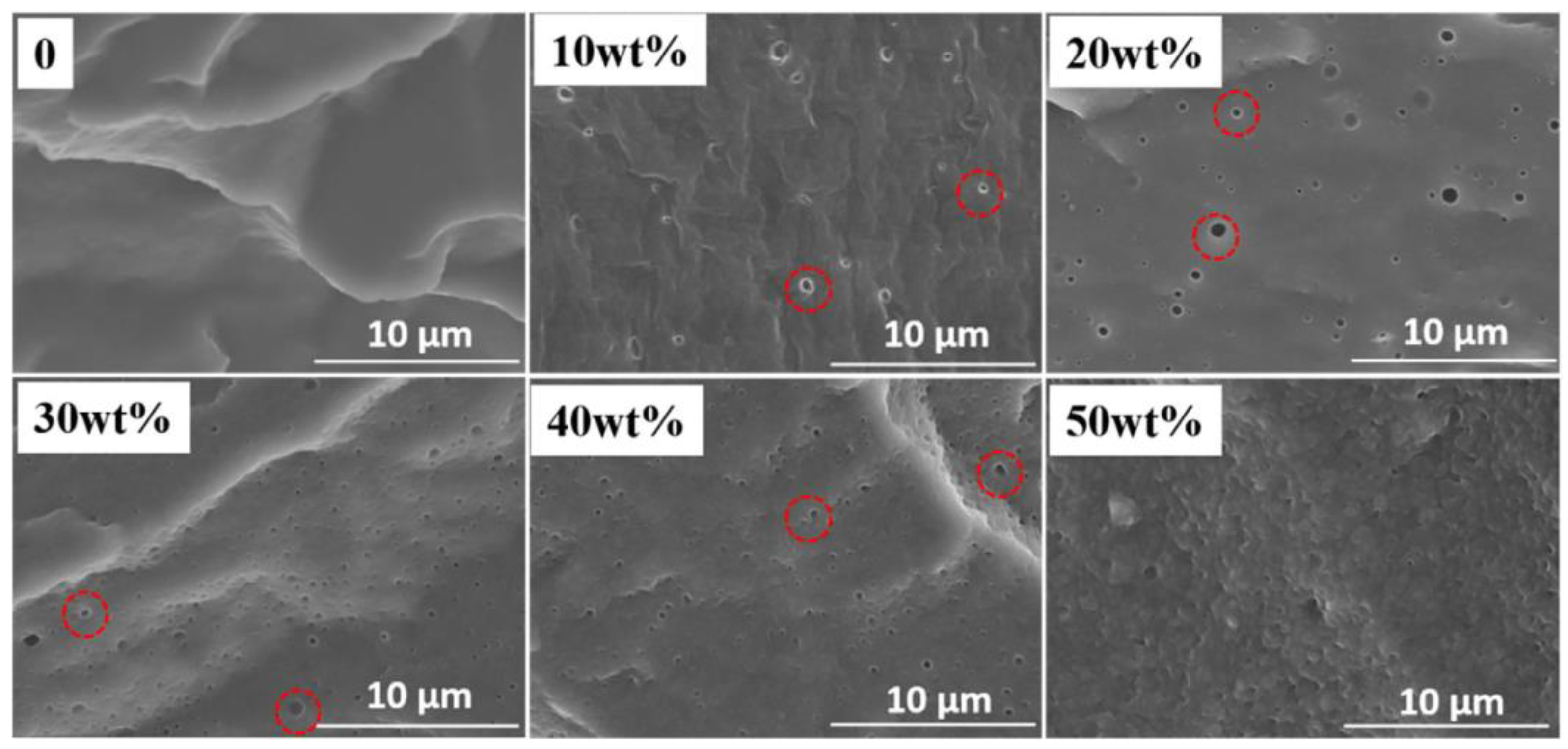
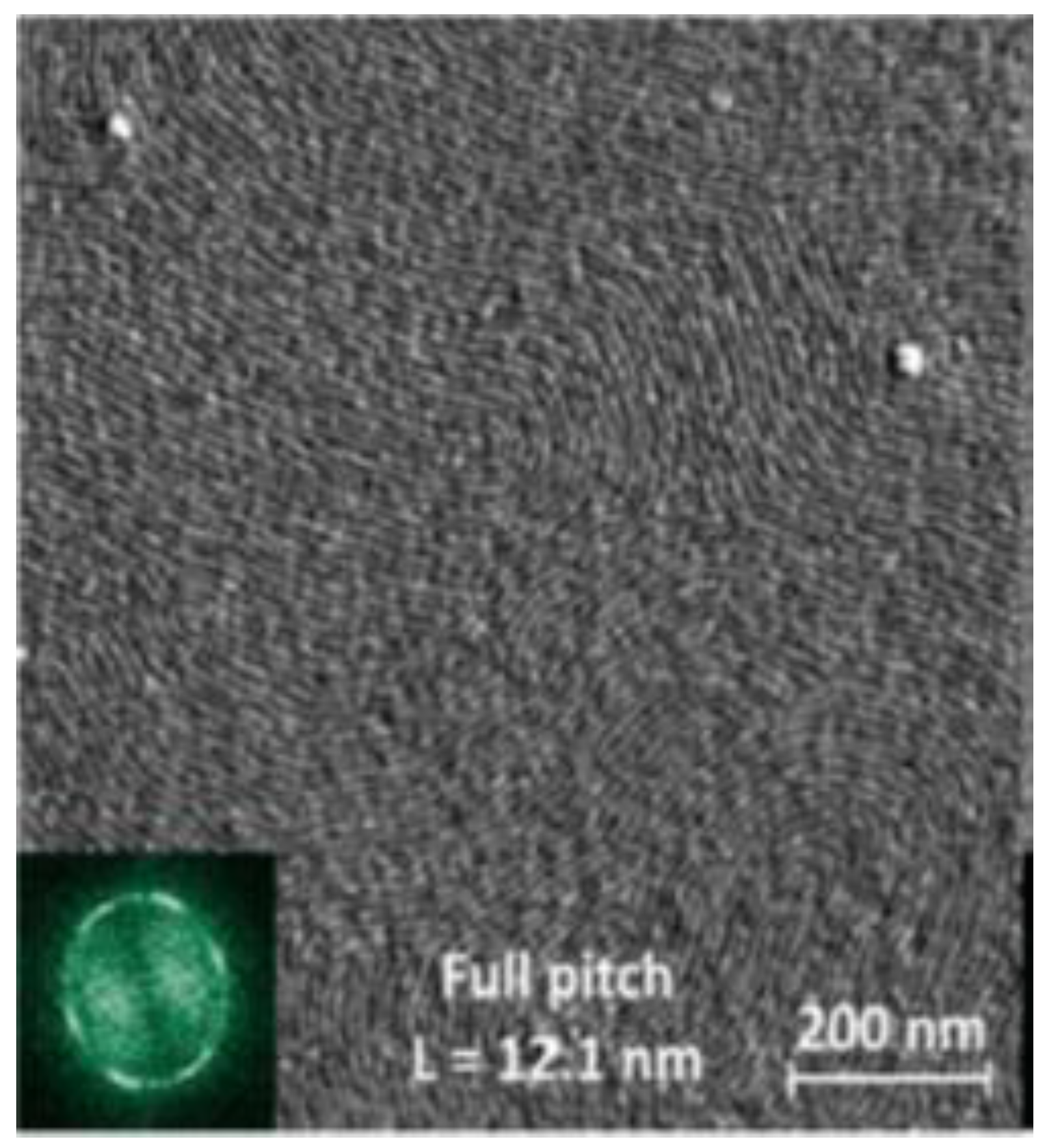
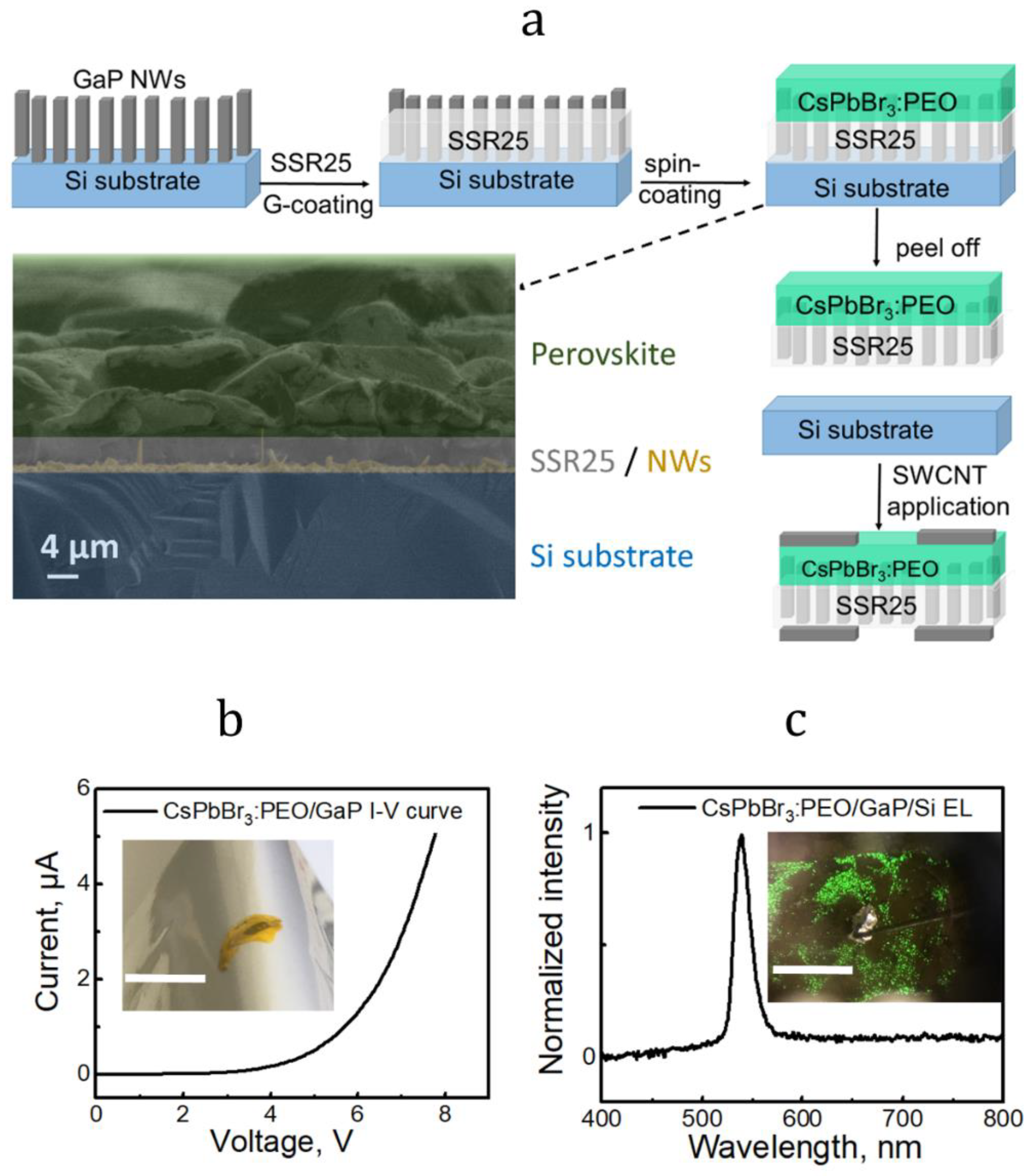

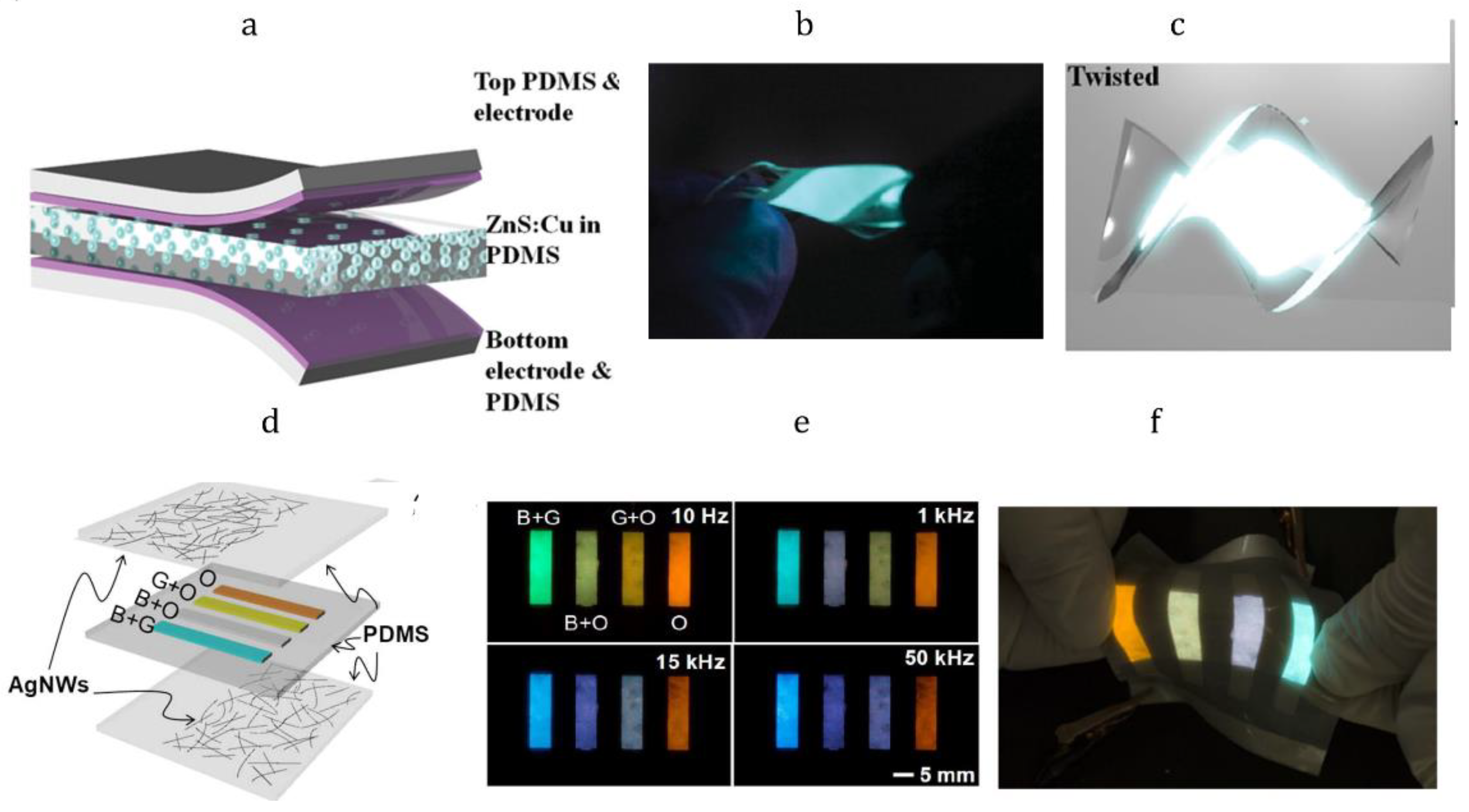
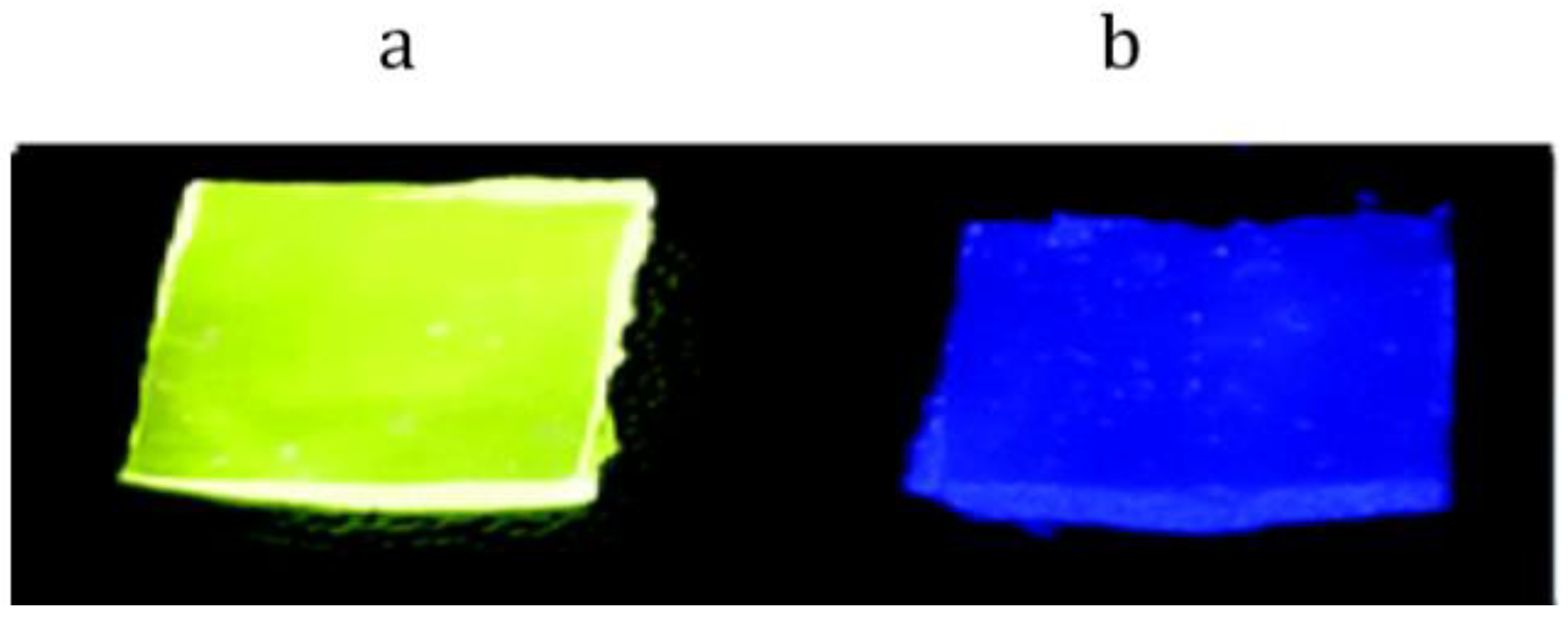


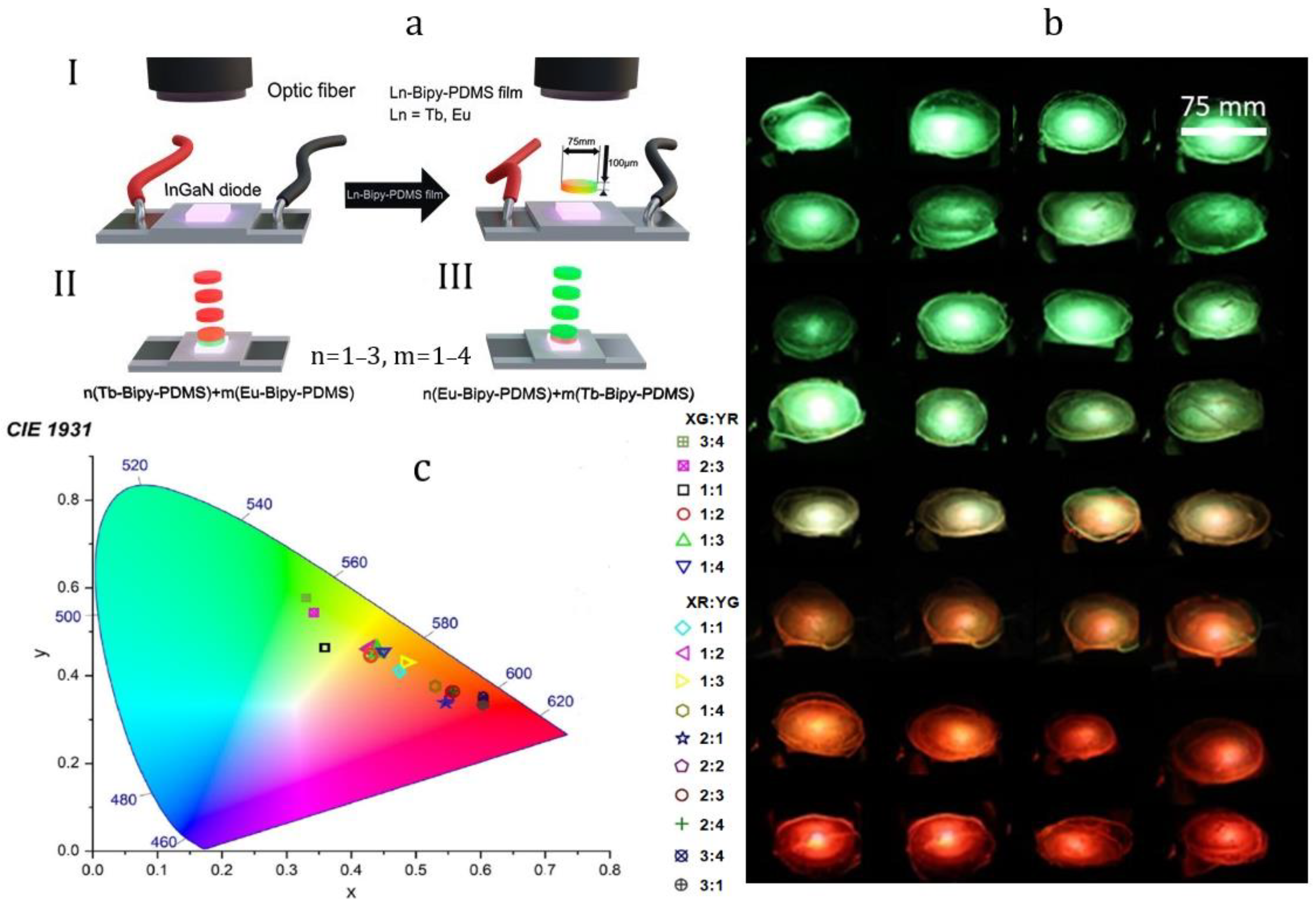
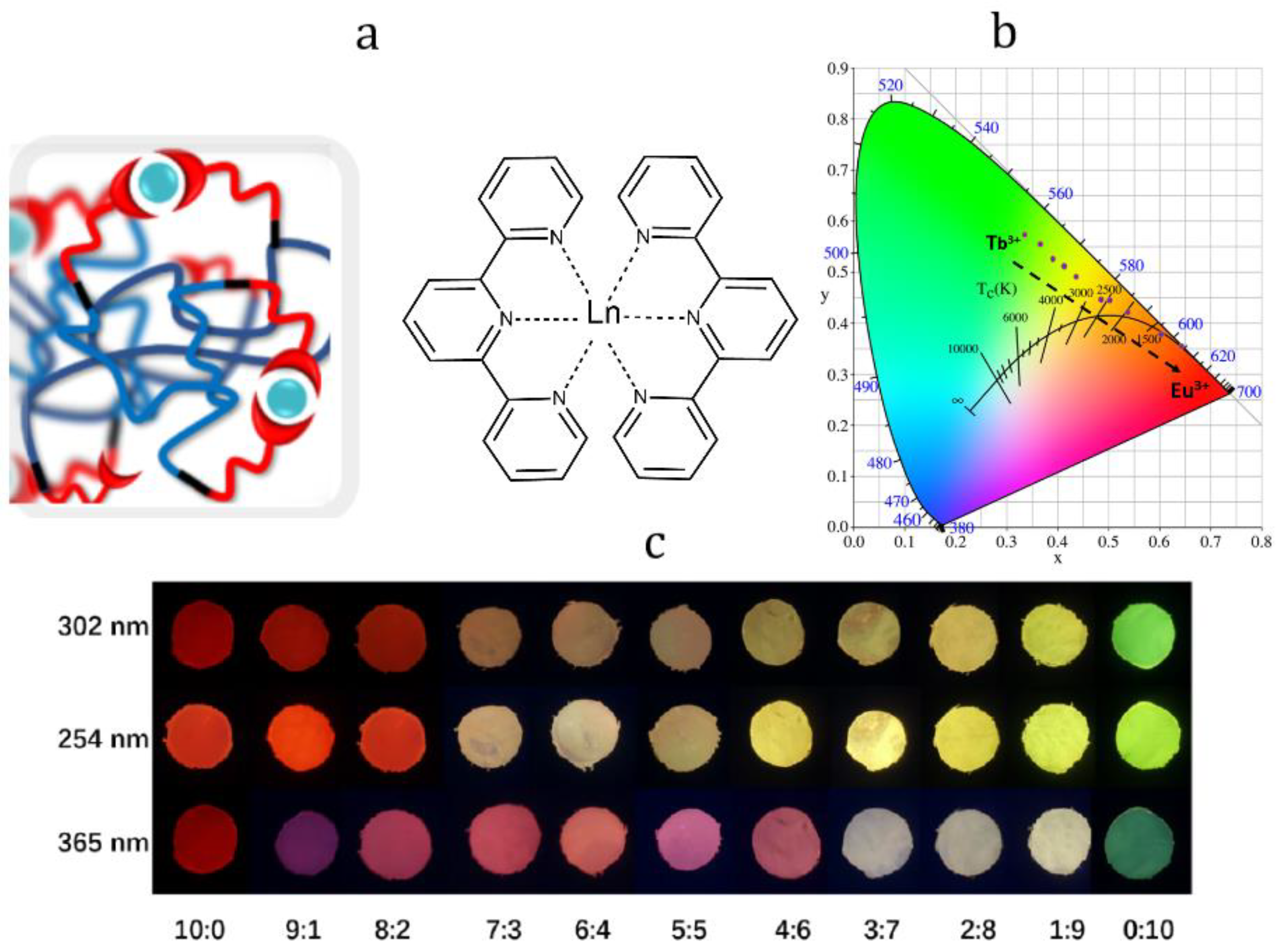
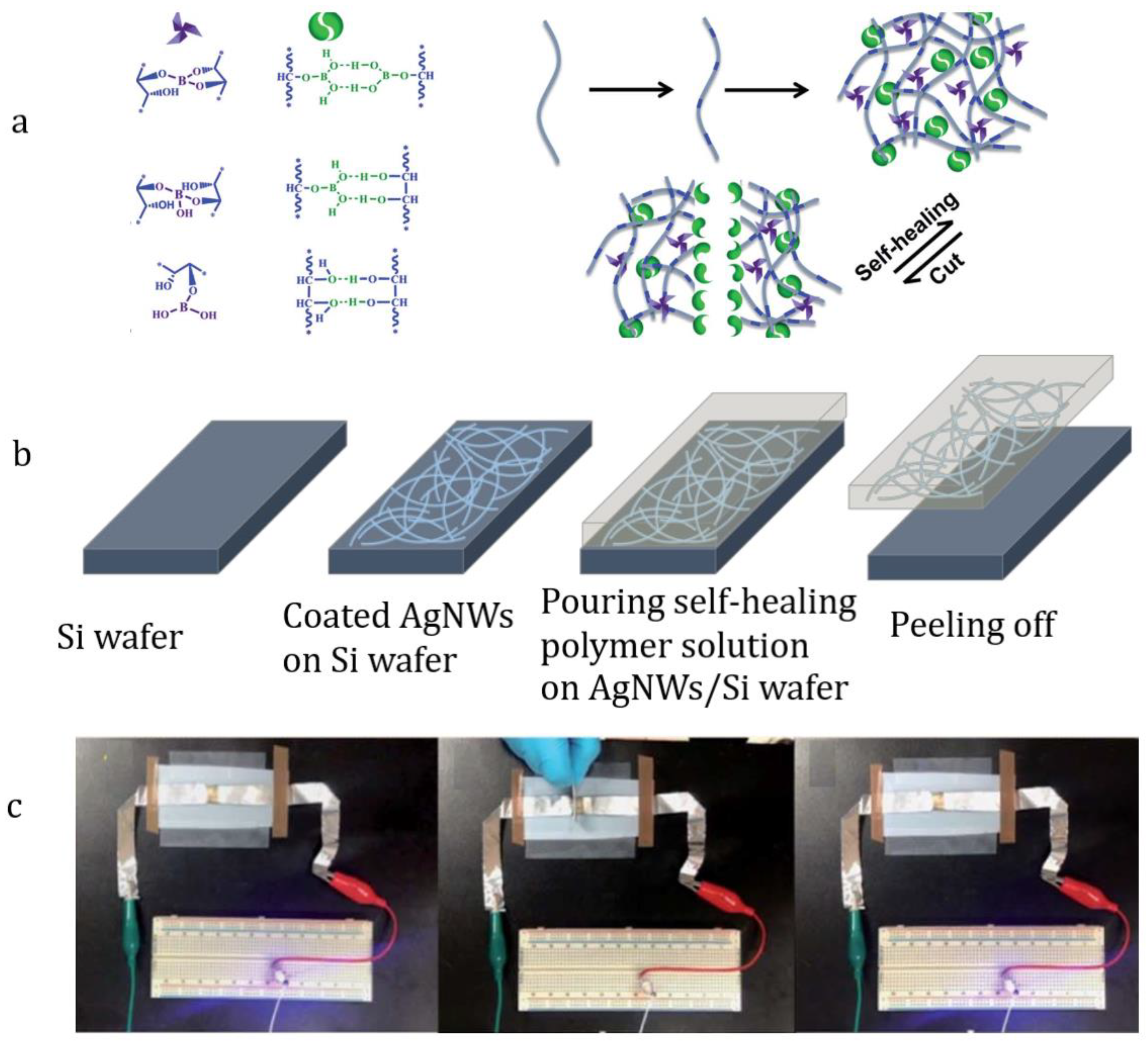
| Silicone Material | σ, MPa | ε, % | E, MPa | References |
|---|---|---|---|---|
| Sylgard 184 | 2.4 | 92 | 1.1 | [46] |
| EFSR | 3.5 | 170 | 1.4 | [69] |
| PDMS-graft-polystyrene | 1.5 | 90 | 1.9 | [59] |
| PDMS–block–PMMA (wt* = 56%) | 4.7 | 61 | – | [62] |
| PDMS–block–PMMA (wt = 6%) | 1.3 | 158 | – | [62] |
| PDMS, polyester–block–polyurethane | 14.3 | 92 | – | [61] |
| Polyester-block-PDMS | 0.5 | 815 | [60] | |
| Zn(CF3SO3)2–PDMS | 0.6 | 310 | 1.1 | [70] |
| Cu–PDMS | 0.39 | 171 | – | [71] |
| Ni–Py–PDMS25000 | 0.04 | 2100 | – | [72] |
| Co–Py–PDMS25000 | 0.05 | 1800 | – | [73] |
| Ln–Py–PDMS | 0.45 | 450 | 1.9 | [20] |
| Ln–Bipy–PDMS | 1.5 | 185 | 3.6 | [74] |
| Ln–Tpy–PDMS (Mn = 5000, L–PU–Ln) | 1.2 | 20 | 13.2 | [75] |
| Ln–Tpy–PDMS (Mn = 25,000, H-PU–Ln) | 0.58 | 498 | 1.7 | [75] |
| PDMS-block-dithiothreitol | 0.43 | 1500 | – | [76] |
Publisher’s Note: MDPI stays neutral with regard to jurisdictional claims in published maps and institutional affiliations. |
© 2022 by the authors. Licensee MDPI, Basel, Switzerland. This article is an open access article distributed under the terms and conditions of the Creative Commons Attribution (CC BY) license (https://creativecommons.org/licenses/by/4.0/).
Share and Cite
Miroshnichenko, A.S.; Neplokh, V.; Mukhin, I.S.; Islamova, R.M. Silicone Materials for Flexible Optoelectronic Devices. Materials 2022, 15, 8731. https://doi.org/10.3390/ma15248731
Miroshnichenko AS, Neplokh V, Mukhin IS, Islamova RM. Silicone Materials for Flexible Optoelectronic Devices. Materials. 2022; 15(24):8731. https://doi.org/10.3390/ma15248731
Chicago/Turabian StyleMiroshnichenko, Anna S., Vladimir Neplokh, Ivan S. Mukhin, and Regina M. Islamova. 2022. "Silicone Materials for Flexible Optoelectronic Devices" Materials 15, no. 24: 8731. https://doi.org/10.3390/ma15248731
APA StyleMiroshnichenko, A. S., Neplokh, V., Mukhin, I. S., & Islamova, R. M. (2022). Silicone Materials for Flexible Optoelectronic Devices. Materials, 15(24), 8731. https://doi.org/10.3390/ma15248731







